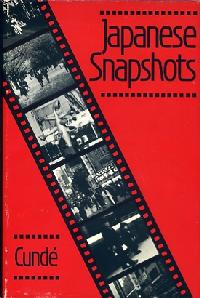Japanese Snapshots
Stories of conflict and harmony
By William Wetherall
A version of this article appeared as
"Stories of conflict and harmony" in
The Japan Times, 10 September 1988, page 14

Cunde (Louis M. Munz) Don't let the title, or the film strip of Tokyo street scenes on the dust cover, or the quote from Ansel Adams in the front, fool you into thinking that Japanese Snapshots is a collection of photographs. It is and it isn't. The nine "snapshots" in this bouncy little album, by Puerto Rico born and educated Cunde -- better known to immigration authorities the world over, to his students at the International Education Center in Tokyo, and to readers of this paper's Guest Forum column as Columbia University ordained Doctor of Education Louis M. Munz -- are actually "short stories" which generally succeed in portraying the "dramatic duality" of old and new Japan. Most of the stories are sharply focused, but some are nicely fuzzy around the edges like vignettes. The book opens with a six-page photomontage of "Shinjuku" in which narrator Cunde sometimes forgets to advance his film or remove his lens cap. The "he" through whose eyes Cunde observes and explains Shinjuku is a fresh-off-the-boat outlander, as he himself once was. Some scenes, though, are double exposed, as when Cunde repeats that sexual favors are available ("Why not?") "for a[n extra] price, of course." Cunde says of the protagonist that "He had not discovered the fleshpots of Shinjuku", yet three pages later the innocent people watcher, aided by the omniscient narrator's telephoto lens, somehow knows that the clip joints are a mere 200 meters down a certain alley. Shinjuku's "he" becomes a more convincing "I" in the four-page follow-up, called "A Cup of Coffee" because that is what "I" thinks about while soaking in a public bath and observing the "fantastic tattoos" all over the back of a one-armed elderly bather, who it turns out had lost one brother in World War II, another in a gang war, and a third to the world of the homeless. Cunde's fictional mood greatly improves with the truly short three-page story "His Last Summer" in which a 17-year-old boy catches his last fish in his favorite stream before her surrenders to the god of time and commits himself to prepping for college entrance exams. In ten pages "A Train to Tokyo" contrasts the different fates of two young college-age men who meet on a train and part never knowing their names, while "Hunger and Thirst" takes seven pages to consummate a date between a 39-year-old Japanese woman, who had resettled in Tokyo after divorcing the American man she had married while becoming a singer in the United States, and a small town boy half her age. The next two stories are about American English teachers in Japan and their students. "The Interview" takes seven pages to say very little about a bored Japanese American nisei from California, who had come to Japan after leaving his nisei wife and two children only to marry another nisei woman in the same "lucrative" language business; and not much more about a job interviewee who wants to work for an international foundation because he met some Southeast Asian students who made him feel ashamed of "the misdeeds committed by Japan" during World War II (though his hobby is visiting old Japanese castles). "The Decision" shows how a 31-year-old Japanese woman goes about getting close to the "half-boy and half-man" American English teacher she has made up her mind to marry. Seventeen pages later, the couple are on a first-name basis, and the reader knows all about Harajuku. These first seven short and short-short stories are hors d'oeuvres for "The Investigation", a fully developed novella that fills like a main course should by showing how the love between a young man and woman is torn by the revelation of her family's outcaste past. Cunde's treatment of this continuing social problem is suspenseful, sensitive, and informed, and he rarely allows the little tour guide that lives in all budding expat novelists to disrupt his fictional dream. The anthology's dessert is "The Letter", a long-short story which explores a woman's decision to divorce her husband. Japanese Snapshots revives the dying genre of fiction by tourists and sojourners who express their impressions of Japan through short stories. While not all of Cunde's stories are models of good fiction (if even of good travelogue), they all meet Ansel Adams' definition of a good snapshot as "something that each of us has seen . . . as human beings, and wants to keep as a memento, a special thing encountered." Cunde's sympathetic yet balanced portrayals of Japan's many kinds of people will entertain even the old Japan hand. And native and non-native reader alike will appreciate his accessible style. Note: The following information is no longer valid. Copies can be purchased outside Japan for $10.95 directly from the publisher (Vantage Press, 516 West 34th St., New York, N.Y. 10001), or in Japan for 2,000 yen including postage from the author (Louis M. Munz, International Education Center, Yotsuya 1-21, Shinjuku-ku, Tokyo 160). |